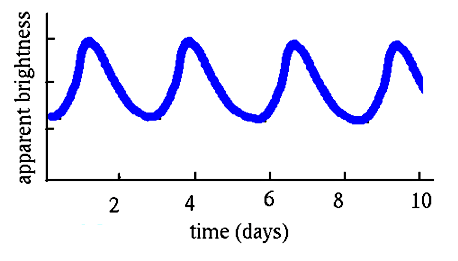Cepheid – Variable Star
By: Wenbin Zhao

INTRODUCTION
· Cepheids, also called Cepheid variables, are stars that brighten and dim periodically. This regular pulsating rhythm is caused by a cycle of ionization of helium which directly influences the opaqueness of a star depending on helium’s ionization degree. At minimum the star is contracted so that the layer has the higher ionization and opacity, and therefore absorbs fusion energy for the star to expand. When the star swells up to a certain size, the ionization suddenly switches from higher to lower, switching the opacity to lower too. The inner fusion energy now radiates easier through this star layer, so the star shrinks to the original contracted state, and the cycle begins anew. The luminosity of the Cepheid stars range from 5-20 times that of the sun.

· A Cepheid is usually categorized into two groups, Type I Cepheid (Population I Giant Yellow Star) or Type II Cepheid (W Virgin’s variable) with Type I encompasses most of the Cepheid. The luminosity of the Cepheid stars range from 5-20 times that of the sun,
Population I – Youngest star in the solar system and has the highest metal content.
Virgin Variable- Population II star which is oldest observed star in the universe. Has low metallicity and lower in luminosity than Type I Cepheid by 1.5 in magnitude.
IMPORTANT CHARACTERISTICS
· Period- Luminosity relationship: in 1900s, Henrietta Leavitt compiled a list of 1,777 periodic variables, and from the plot of period vs.luminosity, she discovered that cepheids with longer periods are intrinsically more luminous than those with shorter periods.
Period-luminosity relationship for Cepheids and RR Lyrae stars.
A more recent calibration was published by Michael Feast and Robin Catchpole in 1997. The resultant period-luminosity relationship was:
Mv- absolute magnitude P- is period measured in days.
So what is the big deal?
Wait, if we incorporate what we learned in class, dada
m - M = 5 log(d/10) so d = 10 (m - M + 5)/5 where m is apparent and M is absolute
So what is next?
If one requires the distance to a given galaxy one first locates the Cepheid variables in this galaxy. From these numbers one can extract the distance to the stars.

Period vs. apparent magnitude

Period vs. Absolute magnitude
Because of relatively high luminosity, Cepheid stars are visible from great distances. The relationship between a Cepheid variable's luminosity and variability period is quite precise, securing Cepheids as a viable standard candle and the foundation of the Extragalactic Distance Scale.
Edwin Hubble first identified some Cepheids in the Andromeda galaxy, thus proving its extragalactic nature (not known at that time). More recently, the Hubble Space Telescope succeeded in identifying some Cepheid stars in the Virgo cluster, at a distance of 60 million light years.
Comments (0)
You don't have permission to comment on this page.